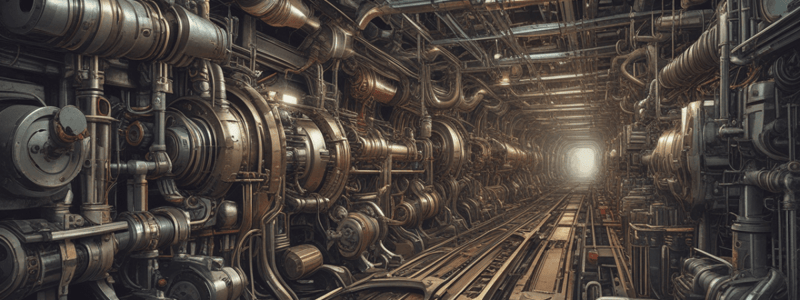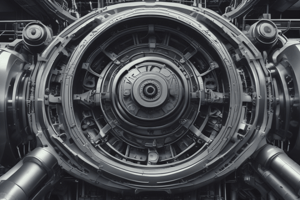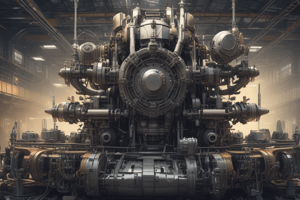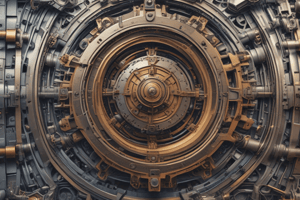Podcast
Questions and Answers
What is the primary objective of metal forming operations?
What is the primary objective of metal forming operations?
- To reduce the cost of production
- To increase the weight of the metal
- To improve the properties of the metal (correct)
- To produce a new shape
What is the main difference between non-cutting shaping and cutting shaping processes?
What is the main difference between non-cutting shaping and cutting shaping processes?
- One uses external forces while the other uses chemical reactions
- One uses heat while the other uses cold working
- One is used for ferrous metals while the other is used for non-ferrous metals
- One involves deformation while the other involves removal of material (correct)
What is the result of plastic deformation on the impurities present in the metal?
What is the result of plastic deformation on the impurities present in the metal?
- They get elongated and dispersed throughout the metal (correct)
- They are completely eliminated
- They become more concentrated and harmful
- They remain unaffected
What is the minimum stress required to cause plastic deformation in a metal?
What is the minimum stress required to cause plastic deformation in a metal?
What is the mechanism by which grains in a metal deform during plastic deformation?
What is the mechanism by which grains in a metal deform during plastic deformation?
What is the primary reason for the increase in plastic deformation at higher temperatures?
What is the primary reason for the increase in plastic deformation at higher temperatures?
What is the term used to describe the lines that appear on the surface of a metal after polishing and etching, indicating the direction of metal flow?
What is the term used to describe the lines that appear on the surface of a metal after polishing and etching, indicating the direction of metal flow?
Which of the following materials is NOT commonly used in engineering practice due to its low ductility?
Which of the following materials is NOT commonly used in engineering practice due to its low ductility?
What is the primary mechanism responsible for strain hardening in metals?
What is the primary mechanism responsible for strain hardening in metals?
What is the term used to describe the process of making a metal harder and stronger through plastic deformation at low temperatures?
What is the term used to describe the process of making a metal harder and stronger through plastic deformation at low temperatures?
What is the primary purpose of hot working?
What is the primary purpose of hot working?
What happens to the grain size of the metal during hot working?
What happens to the grain size of the metal during hot working?
What is the effect of hot working on compositional irregularities in the metal?
What is the effect of hot working on compositional irregularities in the metal?
What is the difference between hot working and cold working in terms of work hardening?
What is the difference between hot working and cold working in terms of work hardening?
What is the effect of hot working on the surface finish of the metal?
What is the effect of hot working on the surface finish of the metal?
What is the primary advantage of hot working in terms of the amount of deformation that can be achieved?
What is the primary advantage of hot working in terms of the amount of deformation that can be achieved?
What is the main reason why some metals cannot be hot worked?
What is the main reason why some metals cannot be hot worked?
What is the primary disadvantage of hot working in terms of the surface finish of the metal?
What is the primary disadvantage of hot working in terms of the surface finish of the metal?
What is the main purpose of cold working?
What is the main purpose of cold working?
What is a limitation of cold working compared to hot working?
What is a limitation of cold working compared to hot working?
What is the minimum cross-sectional area of a bloom?
What is the minimum cross-sectional area of a bloom?
What is the main difference between a slab and a plate?
What is the main difference between a slab and a plate?
What is the advantage of a three-high rolling mill over a two-high rolling mill?
What is the advantage of a three-high rolling mill over a two-high rolling mill?
What is the main application of a two-high reversing mill?
What is the main application of a two-high reversing mill?
What is the minimum thickness of a plate?
What is the minimum thickness of a plate?
What is the difference between a sheet and a strip?
What is the difference between a sheet and a strip?
What type of mill is used for the hot rolling of armor and other plates?
What type of mill is used for the hot rolling of armor and other plates?
What is the direction of rotation of adjacent rolls in a three-high rolling mill?
What is the direction of rotation of adjacent rolls in a three-high rolling mill?
What is the purpose of mechanically operated lifted tables in a three-high rolling mill?
What is the purpose of mechanically operated lifted tables in a three-high rolling mill?
What is the difference between a billet and a bloom?
What is the difference between a billet and a bloom?
What is the primary reason for pickling hot worked metal in acid?
What is the primary reason for pickling hot worked metal in acid?
Which of the following is a disadvantage of cold working?
Which of the following is a disadvantage of cold working?
What is the primary purpose of hot rolling?
What is the primary purpose of hot rolling?
What is the main difference between plates and sheets?
What is the main difference between plates and sheets?
What is the primary advantage of cold rolling over hot rolling?
What is the primary advantage of cold rolling over hot rolling?
What is the primary reason for the loss of strengthening in strain hardened materials when exposed to elevated temperatures?
What is the primary reason for the loss of strengthening in strain hardened materials when exposed to elevated temperatures?
What is the result of recrystallization on the mechanical properties of a strain hardened material?
What is the result of recrystallization on the mechanical properties of a strain hardened material?
What is the primary factor that determines the size of new grains formed during recrystallization?
What is the primary factor that determines the size of new grains formed during recrystallization?
What is the primary reason for the growth of larger grains during grain growth?
What is the primary reason for the growth of larger grains during grain growth?
What is the primary purpose of embossing in cold working operations?
What is the primary purpose of embossing in cold working operations?
Flashcards are hidden until you start studying
Study Notes
Metal Forming
- Metal forming operations are used to produce a new shape or improve the properties of a metal.
- Shaping in the solid state can be divided into non-cutting shaping (e.g., forging, rolling, pressing) and cutting shaping (e.g., machining operations).
Plastic Deformation
- Plastic deformation occurs when a metal is deformed beyond its elastic range.
- The main objectives of metal working processes are to provide the desired shape and size, improve mechanical properties, and reduce internal voids or cavities.
- Metals are commonly worked by plastic deformation, which can be achieved by applying mechanical force or heating the metal and then applying a small force.
Strain Hardening
- Strain hardening (also known as work-hardening or cold-working) is the process of making a metal harder and stronger through plastic deformation.
- Dislocations move and interact with each other, resulting in a decrease in their mobility and a strengthening of the material.
- Strain hardening can be demonstrated by bending a wire or paper clip repeatedly.
Effects of Elevated Temperature on Strain Hardened Materials
- When strain hardened materials are exposed to elevated temperatures, the strengthening that resulted from the plastic deformation can be lost.
- Heat treatment can be used to remove the effects of strain hardening, which involves three stages: recovery, recrystallization, and grain growth.
Recovery
- Recovery occurs when a stain hardened material is held at an elevated temperature, allowing atoms to move to unstrained positions and relieve internal strain energy.
- This results in a reduction in internal residual stresses and a movement of dislocations to lower-energy positions.
Recrystallization
- Recrystallization occurs at a higher temperature, where new, strain-free grains nucleate and grow inside the old distorted grains and at the grain boundaries.
- This results in a return to the original weaker and more ductile states of the material.
Grain Growth
- Grain growth occurs when a specimen is left at a high temperature beyond the time needed for complete recrystallization.
- This results in a decrease in the strength and toughness of the material.
Embossing
- Embossing is a process that involves stretching a metal sheet to shape under pressure using a punch and a die.
- This process gives a stiffening effect to the metal and can produce ornamental wares.
Coining
- Coining is a cold working operation that involves producing shallow configurations on a metal surface using a die and a punch.
- This process is used for producing important articles such as medals, coins, and stickers.
Bending
- Bending is a common process in the manufacturing industry that involves the plastic deformation of a metal sheet over an axis.
- This process changes the shape of the workpiece while maintaining its volume.
Hot Working
- Hot working is a mechanical working process that occurs above the recrystallization temperature of the metal.
- This process is used to produce large deformations and can result in a refined grain structure and improved mechanical properties.
Effects of Hot Working on Mechanical Properties of Metals
- Hot working can produce a refined grain structure and improve mechanical properties.
- It can also reduce the stresses required to produce deformations and increase the possible amount of deformation.
- Hot working can result in a uniform distribution of impurities and improve the surface finish of the metal.
Merits of Hot Working
- Hot working can be used to achieve large deformations without strain hardening.
- It can improve the grain structure and mechanical properties of the metal.
- It can also reduce the stresses required to produce deformations.
Demerits of Hot Working
- Hot working can result in a poor surface finish due to oxidation and scaling.
- It can also lead to a loss of carbon from the surface of the steel, resulting in a loss of strength.
Cold Working
- Cold working is a mechanical working process that occurs below the recrystallization temperature of the metal.
- It is used to obtain better surface finish, increase mechanical properties, and produce thinner materials.
Purpose of Cold Working
- Cold working is used to obtain better surface finish and increase mechanical properties.
- It is also used to produce thinner materials and improve the dimensional accuracy of parts.
Limitations of Cold Working
- Cold working can result in a decrease in ductility and an increase in strain hardening.
- It requires higher forces and more powerful equipment than hot working.
- It can also result in a distortion of the grain structure and the formation of internal stresses.
Advantages of Cold Working
- Cold working can produce a smooth surface finish and accurate dimensions.
- It can increase the strength and hardness of the material.
- It can also result in better dimensional accuracy and a reduction in distortion.
Disadvantages of Cold Working
- Cold working can result in a distortion of the grain structure and the formation of internal stresses.
- It can also limit the amount of deformation that can be given to the material.
- It requires higher forces and more powerful equipment than hot working.
Rolling
- Rolling is a metal forming operation that involves the plastic deformation of a material caused by compressive force applied through a set of rolls.
- It is used to produce a wide range of products, including blooms, billets, plates, and sheets.
- Rolling can be done at high or low temperatures, depending on the desired outcome.### Rolling Process
- Hot rolling produces residual stress-free products, but scaling is a major problem, affecting dimensional accuracy.
- Cold rolling is gaining importance for sheets, foils, etc., due to high accuracy and lack of oxide scaling, and also strengthens the product through work hardening.
Rolling Mills
- Rolling is a major manufacturing process for sheets and other cross-sections of large length, such as I beams, railroads, etc.
- It involves compressing a metal workpiece between a set of rolls, reducing its cross-section area and increasing its length.
- This process offers high production rates, surface finish, and grain structure, but has high setup costs.
Terminology
- Ingot: a cast metal with porosity and blowholes, soaked at 1200°C and rolled into blooms, billets, or slabs.
- Blooms: the first rolled product, made by rolling ingot at high temperature, with a cross-section area ≥ 230 cm².
- Slab: made by hot rolling of ingot, with a cross-section area ≥ 100 cm² and width ≥ 3 times its thickness.
- Billets: made by hot rolling of blooms, with a cross-section area ≥ 40 cm², used to roll into pipes, bars, wire, etc.
- Plate: a product of further rolling of slab, with a thickness > 6 mm.
- Sheet: a product with a thickness < 6 mm and width > 60 cm.
- Strip: a product with a thickness < 6 mm and width < 60 cm.
Types of Rolling Mills
- Two high reversing mill: rolls rotate in one direction and then in the other, allowing the metal to pass back and forth through the rolls several times.
- Two high non-reversing mill: rolls revolve continuously in one direction, requiring smaller and less costly motive power.
- Three high rolling mill: consists of three parallel rolls, with adjacent rolls rotating in opposite directions, reducing thickness at each pass.
- Four high rolling mill: used for hot rolling of armor and other plates, as well as cold rolling of plates, sheets, and strips.
- Tandem rolling mills: used for rolling multiple stands in a continuous process.
Studying That Suits You
Use AI to generate personalized quizzes and flashcards to suit your learning preferences.





